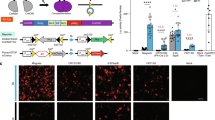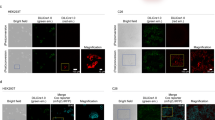Abstract
Genome engineering techniques represented by the Cre–loxP recombination system have been used extensively for biomedical research. However, powerful and useful techniques for genome engineering that have high spatiotemporal precision remain elusive. Here we develop a highly efficient photoactivatable Cre recombinase (PA-Cre) to optogenetically control genome engineering in vivo. PA-Cre is based on the reassembly of split Cre fragments by light-inducible dimerization of the Magnet system. PA-Cre enables sharp induction (up to 320-fold) of DNA recombination and is efficiently activated even by low-intensity illumination (∼0.04 W m−2) or short periods of pulsed illumination (∼30 s). We demonstrate that PA-Cre allows for efficient DNA recombination in an internal organ of living mice through noninvasive external illumination using a LED light source. The present PA-Cre provides a powerful tool to greatly facilitate optogenetic genome engineering in vivo.
This is a preview of subscription content, access via your institution
Access options
Subscribe to this journal
Receive 12 print issues and online access
$259.00 per year
only $21.58 per issue
Buy this article
- Purchase on Springer Link
- Instant access to full article PDF
Prices may be subject to local taxes which are calculated during checkout





Similar content being viewed by others
References
Akopian, A. & Marshall Stark, W. Site-specific DNA recombinases as instruments for genomic surgery. Adv. Genet. 55, 1–23 (2005).
Gaj, T., Sirk, S.J. & Barbas, C.F. III. Expanding the scope of site-specific recombinases for genetic and metabolic engineering. Biotechnol. Bioeng. 111, 1–15 (2014).
Van Duyne, G.D. Cre recombinase. Microbiol. Spectr. 3, http://dx.doi.org/10.1128/microbiolspec.MDNA3-0014-2014 (2015).
Meinke, G., Bohm, A., Hauber, J., Pisabarro, M.T. & Buchholz, F. Cre recombinase and other tyrosine recombinases. Chem. Rev. (2016).
Sternberg, N. Bacteriophage P1 site-specific recombination. III. Strand exchange during recombination at lox sites. J. Mol. Biol. 150, 603–608 (1981).
Madisen, L. et al. A robust and high-throughput Cre reporting and characterization system for the whole mouse brain. Nat. Neurosci. 13, 133–140 (2010).
Gierut, J.J., Jacks, T.E. & Haigis, K.M. Strategies to achieve conditional gene mutation in mice. Cold Spring Harb. Protoc. 2014, 339–349 (2014).
Kellendonk, C. et al. Regulation of Cre recombinase activity by the synthetic steroid RU 486. Nucleic Acids Res. 24, 1404–1411 (1996).
Feil, R., Wagner, J., Metzger, D. & Chambon, P. Regulation of Cre recombinase activity by mutated estrogen receptor ligand-binding domains. Biochem. Biophys. Res. Commun. 237, 752–757 (1997).
Casanova, E. et al. ER-based double iCre fusion protein allows partial recombination in forebrain. Genesis 34, 208–214 (2002).
Jullien, N., Sampieri, F., Enjalbert, A. & Herman, J.P. Regulation of Cre recombinase by ligand-induced complementation of inactive fragments. Nucleic Acids Res. 31, e131 (2003).
Guo, Z.M. et al. Temporal control of Cre recombinase-mediated in vitro DNA recombination by Tet-on gene expression system. Acta Biochim. Biophys. Sin. (Shanghai) 37, 133–138 (2005).
Sando, R. III et al. Inducible control of gene expression with destabilized Cre. Nat. Methods 10, 1085–1088 (2013).
Chen, D., Wu, C.F., Shi, B. & Xu, Y.M. Tamoxifen and toremifene cause impairment of learning and memory function in mice. Pharmacol. Biochem. Behav. 71, 269–276 (2002).
Roshangar, L., Rad, J.S. & Afsordeh, K. Maternal tamoxifen treatment alters oocyte differentiation in the neonatal mice: inhibition of oocyte development and decreased folliculogenesis. J. Obstet. Gynaecol. Res. 36, 224–231 (2010).
Laplante, M. & Sabatini, D.M. mTOR signaling in growth control and disease. Cell 149, 274–293 (2012).
Link, K.H., Shi, Y. & Koh, J.T. Light activated recombination. J. Am. Chem. Soc. 127, 13088–13089 (2005).
Edwards, W.F., Young, D.D. & Deiters, A. Light-activated Cre recombinase as a tool for the spatial and temporal control of gene function in mammalian cells. ACS Chem. Biol. 4, 441–445 (2009).
Lu, X. et al. Optochemogenetics (OCG) allows more precise control of genetic engineering in mice with CreER regulators. Bioconjug. Chem. 23, 1945–1951 (2012).
Inlay, M.A. et al. Synthesis of a photocaged tamoxifen for light-dependent activation of Cre-ER recombinase-driven gene modification. Chem. Commun. (Camb.) 49, 4971–4973 (2013).
Gorka, A.P., Nani, R.R., Zhu, J., Mackem, S. & Schnermann, M.J. A near-IR uncaging strategy based on cyanine photochemistry. J. Am. Chem. Soc. 136, 14153–14159 (2014).
Brown, K.A. et al. Light-cleavable rapamycin dimer as an optical trigger for protein dimerization. Chem. Commun. (Camb.) 51, 5702–5705 (2015).
Faal, T. et al. 4-Hydroxytamoxifen probes for light-dependent spatiotemporal control of Cre-ER mediated reporter gene expression. Mol. Biosyst. 11, 783–790 (2015).
Luo, J. et al. Genetically encoded optical activation of DNA recombination in human cells. Chem. Commun. (Camb.) 52, 8529–8532 (2016).
Kennedy, M.J. et al. Rapid blue-light-mediated induction of protein interactions in living cells. Nat. Methods 7, 973–975 (2010).
Boulina, M., Samarajeewa, H., Baker, J.D., Kim, M.D. & Chiba, A. Live imaging of multicolor-labeled cells in Drosophila. Development 140, 1605–1613 (2013).
Schindler, S.E. et al. Photo-activatable Cre recombinase regulates gene expression in vivo. Sci. Rep. 5, 13627 (2015).
Kawano, F., Suzuki, H., Furuya, A. & Sato, M. Engineered pairs of distinct photoswitches for optogenetic control of cellular proteins. Nat. Commun. 6, 6256 (2015).
Zoltowski, B.D. et al. Conformational switching in the fungal light sensor Vivid. Science 316, 1054–1057 (2007).
Zhang, Z. & Lutz, B. Cre recombinase-mediated inversion using lox66 and lox71: method to introduce conditional point mutations into the CREB-binding protein. Nucleic Acids Res. 30, e90 (2002).
Thomson, J.G., Rucker, E.B. III & Piedrahita, J.A. Mutational analysis of loxP sites for efficient Cre-mediated insertion into genomic DNA. Genesis 36, 162–167 (2003).
Oberdoerffer, P., Otipoby, K.L., Maruyama, M. & Rajewsky, K. Unidirectional Cre-mediated genetic inversion in mice using the mutant loxP pair lox66/lox71. Nucleic Acids Res. 31, e140 (2003).
Livet, J. et al. Transgenic strategies for combinatorial expression of fluorescent proteins in the nervous system. Nature 450, 56–62 (2007).
Sohal, V.S., Zhang, F., Yizhar, O. & Deisseroth, K. Parvalbumin neurons and gamma rhythms enhance cortical circuit performance. Nature 459, 698–702 (2009).
Araki, K., Okada, Y., Araki, M. & Yamamura, K. Comparative analysis of right element mutant lox sites on recombination efficiency in embryonic stem cells. BMC Biotechnol. 10, 29 (2010).
Cai, D., Cohen, K.B., Luo, T., Lichtman, J.W. & Sanes, J.R. Improved tools for the Brainbow toolbox. Nat. Methods 10, 540–547 (2013).
Fenno, L.E. et al. Targeting cells with single vectors using multiple-feature Boolean logic. Nat. Methods 11, 763–772 (2014).
Lee, G. & Saito, I. Role of nucleotide sequences of loxP spacer region in Cre-mediated recombination. Gene 216, 55–65 (1998).
Langer, S.J., Ghafoori, A.P., Byrd, M. & Leinwand, L. A genetic screen identifies novel non-compatible loxP sites. Nucleic Acids Res. 30, 3067–3077 (2002).
Guo, F., Gopaul, D.N. & van Duyne, G.D. Structure of Cre recombinase complexed with DNA in a site-specific recombination synapse. Nature 389, 40–46 (1997).
Vaidya, A.T., Chen, C.H., Dunlap, J.C., Loros, J.J. & Crane, B.R. Structure of a light-activated LOV protein dimer that regulates transcription. Sci. Signal. 4, ra50 (2011).
Kim, J.H. et al. High cleavage efficiency of a 2A peptide derived from porcine teschovirus-1 in human cell lines, zebrafish and mice. PLoS One 6, e18556 (2011).
Shimshek, D.R. et al. Codon-improved Cre recombinase (iCre) expression in the mouse. Genesis 32, 19–26 (2002).
Guo, F., Gopaul, D.N. & Van Duyne, G.D. Asymmetric DNA bending in the Cre-loxP site-specific recombination synapse. Proc. Natl. Acad. Sci. USA 96, 7143–7148 (1999).
Liu, F., Song, Y. & Liu, D. Hydrodynamics-based transfection in animals by systemic administration of plasmid DNA. Gene Ther. 6, 1258–1266 (1999).
Gautier, A. et al. How to control proteins with light in living systems. Nat. Chem. Biol. 10, 533–541 (2014).
Taslimi, A. et al. Optimized second-generation CRY2-CIB dimerizers and photoactivatable Cre recombinase. Nat. Chem. Biol. 12, 425–430 (2016).
Casanova, E., Lemberger, T., Fehsenfeld, S., Mantamadiotis, T. & Schütz, G. Alpha complementation in the Cre recombinase enzyme. Genesis 37, 25–29 (2003).
Tang, J.C. et al. Cell type-specific manipulation with GFP-dependent Cre recombinase. Nat. Neurosci. 18, 1334–1341 (2015).
Müller, K., Naumann, S., Weber, W. & Zurbriggen, M.D. Optogenetics for gene expression in mammalian cells. Biol. Chem. 396, 145–152 (2015).
Ganter, B., Fu, Sl. & Lipsick, J.S. D-type cyclins repress transcriptional activation by the v-Myb but not the c-Myb DNA-binding domain. EMBO J. 17, 255–268 (1998).
Rogers, S., Wells, R. & Rechsteiner, M. Amino acid sequences common to rapidly degraded proteins: the PEST hypothesis. Science 234, 364–368 (1986).
Shaner, N.C. et al. Improved monomeric red, orange and yellow fluorescent proteins derived from Discosoma sp. red fluorescent protein. Nat. Biotechnol. 22, 1567–1572 (2004).
Acknowledgements
We thank Y. Nihongaki for his technical assistance in experiments with mice. We also thank S.E. Park, J.R. Quejada and S. Su for proofreading the manuscript. This work was supported by Platform for Dynamic Approaches to Living System from the Ministry of Education, Culture, Sports, Science and Technology, Japan (MEXT) and Japan Agency for Medical Research and Development (AMED). This work was also supported by a grant from the Takeda Science Foundation to M.S. This work was also supported by grants from Japan Society for the Promotion of Science (JSPS) to M.S. and JSPS Postdoctoral Fellowships for Research Abroad to F.K.
Author information
Authors and Affiliations
Contributions
F.K., R.O. and M.S. conceived the project and designed the experiments. F.K. and R.O. performed the experiments. F.K., R.O. and M.S. wrote the manuscript. F.K., M.Y. and M.S. edited the manuscript and reviewed the data.
Corresponding author
Ethics declarations
Competing interests
The authors declare no competing financial interests.
Supplementary information
Supplementary Text and Figures
Supplementary Results, Supplementary Figures 1–13, Supplementary References and Supplementary Note. (PDF 12292 kb)
Rights and permissions
About this article
Cite this article
Kawano, F., Okazaki, R., Yazawa, M. et al. A photoactivatable Cre–loxP recombination system for optogenetic genome engineering. Nat Chem Biol 12, 1059–1064 (2016). https://doi.org/10.1038/nchembio.2205
Received:
Accepted:
Published:
Issue Date:
DOI: https://doi.org/10.1038/nchembio.2205
This article is cited by
-
A tissue specific-infection mouse model of SARS-CoV-2
Cell Discovery (2023)
-
Ribo-On and Ribo-Off tools using a self-cleaving ribozyme allow manipulation of endogenous gene expression in C. elegans
Communications Biology (2023)
-
The emergence of molecular systems neuroscience
Molecular Brain (2022)
-
A CRISPR toolbox for generating intersectional genetic mouse models for functional, molecular, and anatomical circuit mapping
BMC Biology (2022)
-
A red light–responsive photoswitch for deep tissue optogenetics
Nature Biotechnology (2022)



